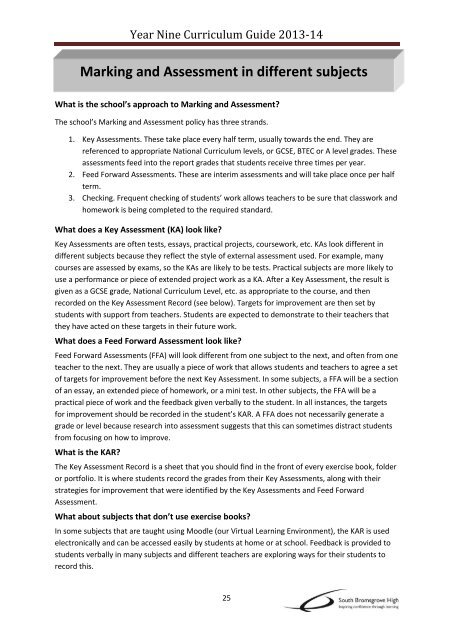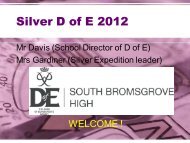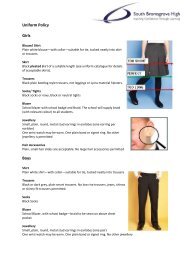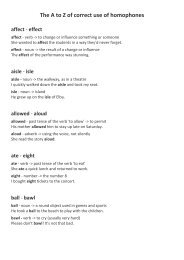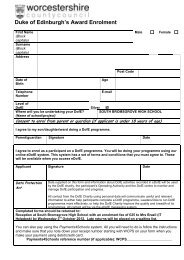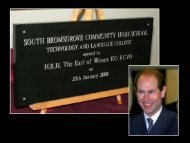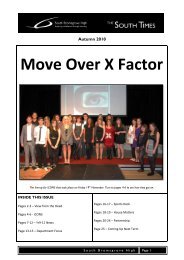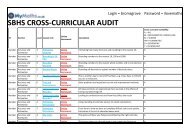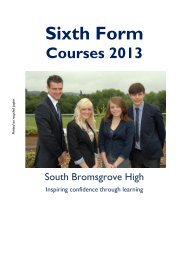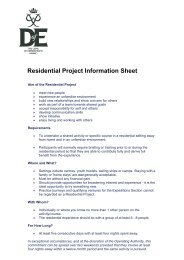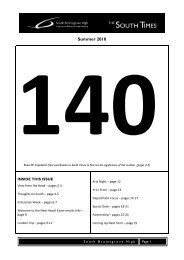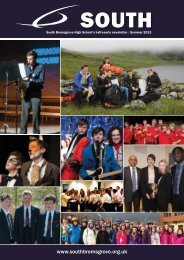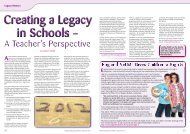Year 9 Curriculum Guide - South Bromsgrove High School ...
Year 9 Curriculum Guide - South Bromsgrove High School ...
Year 9 Curriculum Guide - South Bromsgrove High School ...
Create successful ePaper yourself
Turn your PDF publications into a flip-book with our unique Google optimized e-Paper software.
<strong>Year</strong> Nine <strong>Curriculum</strong> <strong>Guide</strong> 2013-14<br />
Marking and Assessment in different subjects<br />
What is the school’s approach to Marking and Assessment?<br />
The school’s Marking and Assessment policy has three strands.<br />
1. Key Assessments. These take place every half term, usually towards the end. They are<br />
referenced to appropriate National <strong>Curriculum</strong> levels, or GCSE, BTEC or A level grades. These<br />
assessments feed into the report grades that students receive three times per year.<br />
2. Feed Forward Assessments. These are interim assessments and will take place once per half<br />
term.<br />
3. Checking. Frequent checking of students’ work allows teachers to be sure that classwork and<br />
homework is being completed to the required standard.<br />
What does a Key Assessment (KA) look like?<br />
Key Assessments are often tests, essays, practical projects, coursework, etc. KAs look different in<br />
different subjects because they reflect the style of external assessment used. For example, many<br />
courses are assessed by exams, so the KAs are likely to be tests. Practical subjects are more likely to<br />
use a performance or piece of extended project work as a KA. After a Key Assessment, the result is<br />
given as a GCSE grade, National <strong>Curriculum</strong> Level, etc. as appropriate to the course, and then<br />
recorded on the Key Assessment Record (see below). Targets for improvement are then set by<br />
students with support from teachers. Students are expected to demonstrate to their teachers that<br />
they have acted on these targets in their future work.<br />
What does a Feed Forward Assessment look like?<br />
Feed Forward Assessments (FFA) will look different from one subject to the next, and often from one<br />
teacher to the next. They are usually a piece of work that allows students and teachers to agree a set<br />
of targets for improvement before the next Key Assessment. In some subjects, a FFA will be a section<br />
of an essay, an extended piece of homework, or a mini test. In other subjects, the FFA will be a<br />
practical piece of work and the feedback given verbally to the student. In all instances, the targets<br />
for improvement should be recorded in the student’s KAR. A FFA does not necessarily generate a<br />
grade or level because research into assessment suggests that this can sometimes distract students<br />
from focusing on how to improve.<br />
What is the KAR?<br />
The Key Assessment Record is a sheet that you should find in the front of every exercise book, folder<br />
or portfolio. It is where students record the grades from their Key Assessments, along with their<br />
strategies for improvement that were identified by the Key Assessments and Feed Forward<br />
Assessment.<br />
What about subjects that don’t use exercise books?<br />
In some subjects that are taught using Moodle (our Virtual Learning Environment), the KAR is used<br />
electronically and can be accessed easily by students at home or at school. Feedback is provided to<br />
students verbally in many subjects and different teachers are exploring ways for their students to<br />
record this.<br />
25


